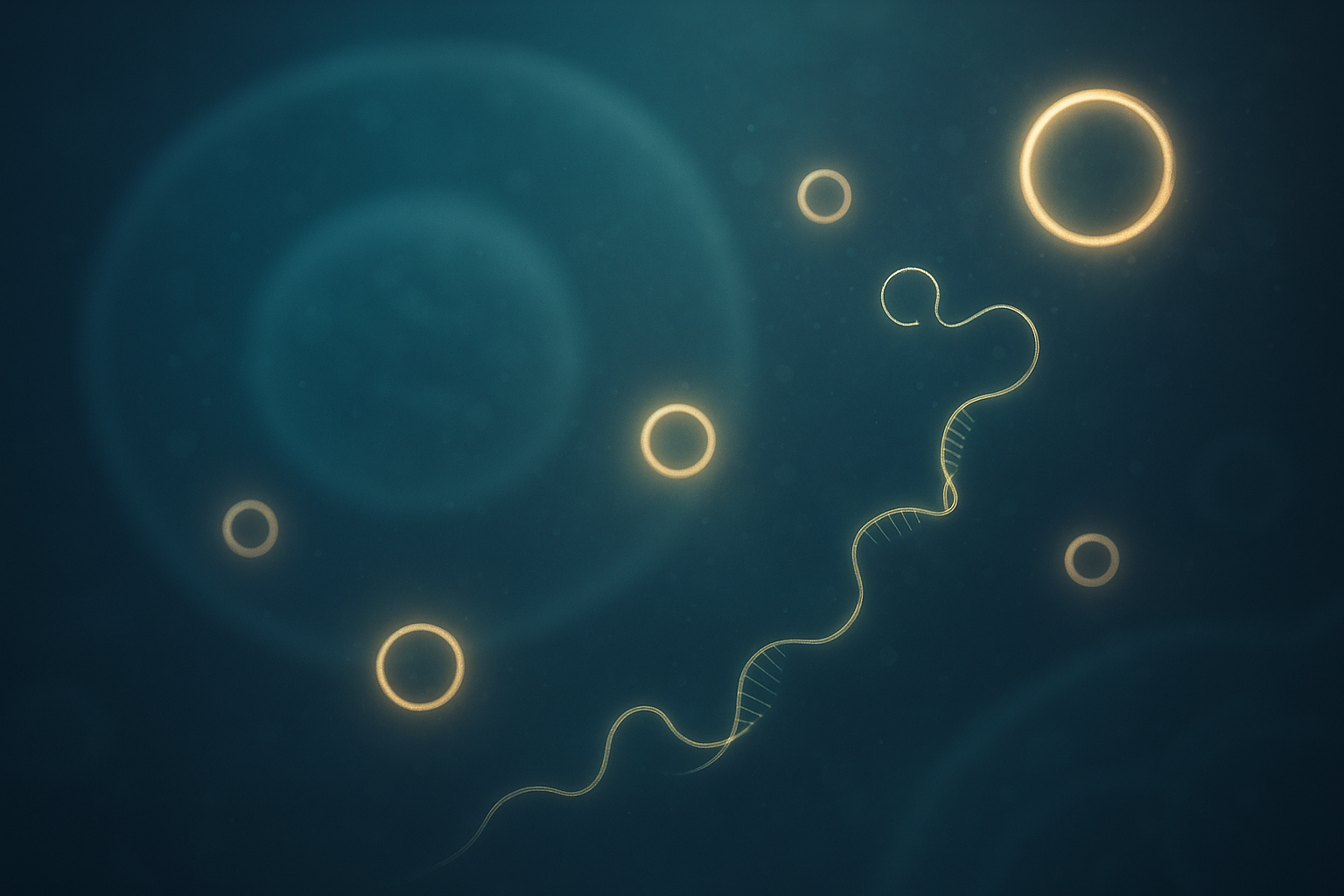Inside plant cells, there is circular DNA—extrachromosomal circular DNA (eccDNA)—that exists apart from the chromosomes. Most of it forms as by-products of DNA repair or transposable element (TE) activity—basically scraps of the blueprint headed for the trash. But a small subset becomes “useful memo notes”: they can temporarily boost gene copy number, get reinserted into chromosomes as raw material for rearrangements, or serve as a timestamp of recent TE activity. Using this mental model, I introduce a new PLOS Biology paper that maps full-length eccDNA in Arabidopsis thaliana by reading very long DNA molecules. It starts to make visible what used to be invisible—genuinely fun science.
Reference: A comprehensive atlas of full-length Arabidopsis eccDNA populations identifies their genomic origins and epigenetic regulation (PLOS Biology, published July 15, 2025)
- What is eccDNA? — Blueprint Scraps: “Mostly Trash, Occasionally Treasure”
- Aim of the Study: Building a Full-Length eccDNA Atlas of Origins and Control
- Methods in a Nutshell: RCA × Long Reads = “Spin the Ring and Read It Long”
- Key Results: Centromere-Proximal Hotspots / TEs and Epigenome as the Levers
- What This Study Teaches: How to Spot the “Useful Memos,” and Cautions
- Outlook: From Stress Readouts to Breeding Monitors
What is eccDNA? — Blueprint Scraps: “Mostly Trash, Occasionally Treasure”
eccDNA is a circular, extrachromosomal DNA found widely across eukaryotes. Most eccDNAs are small, fragmentary pieces arising during DNA break repair or as part of TE life cycles. Over time they are degraded or diluted by cell division and do not carry functions. Occasionally, an eccDNA contains a full gene, enabling a temporary copy-number boost; eccDNA can also be reinserted into chromosomes, contributing to duplications or rearrangements. Importantly, eccDNA can act as an activity log—evidence that a particular TE moved recently. The study highlighted here captures full-length eccDNAs in plants and shows their relationships to TE dynamics and the epigenome at high resolution—new and important.
Aim of the Study: Building a Full-Length eccDNA Atlas of Origins and Control
Short-read sequencing often misses full-length eccDNAs, especially those derived from TEs. The authors used CIDER-Seq, a long-read workflow: enrich circular DNA via rolling circle amplification (RCA) → sequence long molecules → identify circular origin from repeat units. They profiled Arabidopsis across tissues (leaf, callus, shoot apex), heat stress, and epigenome-related mutants (dcl3, rdr6, ros1, ddm1) to generate a comprehensive atlas. The goals: where eccDNA tends to originate and how epigenetic repression (e.g., DNA methylation) shapes its formation.
Methods in a Nutshell: RCA × Long Reads = “Spin the Ring and Read It Long”
Core step: RCA continuously copies a circular template at a constant temperature. Phi29 DNA polymerase runs multiple laps around the circle, producing a concatemer—the same sequence repeated end-to-end. Long-read sequencing (e.g., PacBio HiFi/CCS) captures these long products, and a deconcat algorithm disentangles the repeats to flag circle-derived reads. Because RCA preferentially amplifies circles, eccDNAs can be enriched against abundant linear genomic DNA. Note a caveat: small circles amplify more easily, so the authors use pre-/post-processing to mitigate size bias. As a Methods and Resources paper, data and code are openly available.
Key Results: Centromere-Proximal Hotspots / TEs and Epigenome as the Levers
Let’s look at what eccDNA is—and isn’t—doing.
- Origins: eccDNAs are enriched near centromeres and frequently derived from Helitron and LTR retrotransposon families. Note: Transposable elements are DNA sequences that can move to new locations and influence genome function and evolution.
- Stress: Under heat stress, eccDNA from the known ATCOPIA78/ONSEN retrotransposon rises sharply—consistent with it being a “recent TE activity log.”
- Mutants: In ros1 and other backgrounds, certain TE classes (e.g., LTR/Gypsy) preferentially increase, shifting the composition of eccDNA—evidence that specific epigenetic pathways shape eccDNA output.
- Cell State: Callus and the shoot apical meristem (SAM)—proliferative/“stem-like” contexts—show enrichment of eccDNAs (e.g., LTR/Copia). In SAM, candidates like ATCOPIA58 emerge as potential mobile TEs.
Taken together, TE activity × epigenome × cellular state jointly tune how often these “blueprint scraps” appear.
What This Study Teaches: How to Spot the “Useful Memos,” and Cautions
The value here is a full-length map that helps separate “just trash” from “possibly useful memos” by TE class, genomic location, and condition—a sorting chart for blueprint scraps. Caveats remain: RCA size bias, library prep bias, etc. So extra validation (transcriptional impact, protein effects, reintegration tracking) is required before calling any eccDNA a “treasure.” The authors stay cautious: the core achievement is sharpening where eccDNA comes from and how it is regulated. That’s fundamental research—you don’t always know the payoff, but it expands what’s possible ten years from now.
Outlook: From Stress Readouts to Breeding Monitors
Even now, some uses seem plausible. Treat eccDNA as a biomarker of TE activity: track responses to heat/drought stress or callus/regeneration phases; flag early warnings of herbicide resistance (e.g., copy-number increases or large eccDNAs). On the flip side, reintegration and copy-number swings are double-edged, potentially destabilizing. To avoid unwanted effects, we’ll need robust assays to identify true “treasures”—e.g., single-cell readouts, long-read genomics, and integrated methylome/transcriptome layers.
It may sound technical, but the punchline is simple: we can now analyze a quirky class of DNA that used to be a blur. Most of it is trash; some of it might be a game-changer. I’m excited to see where this goes.



コメント